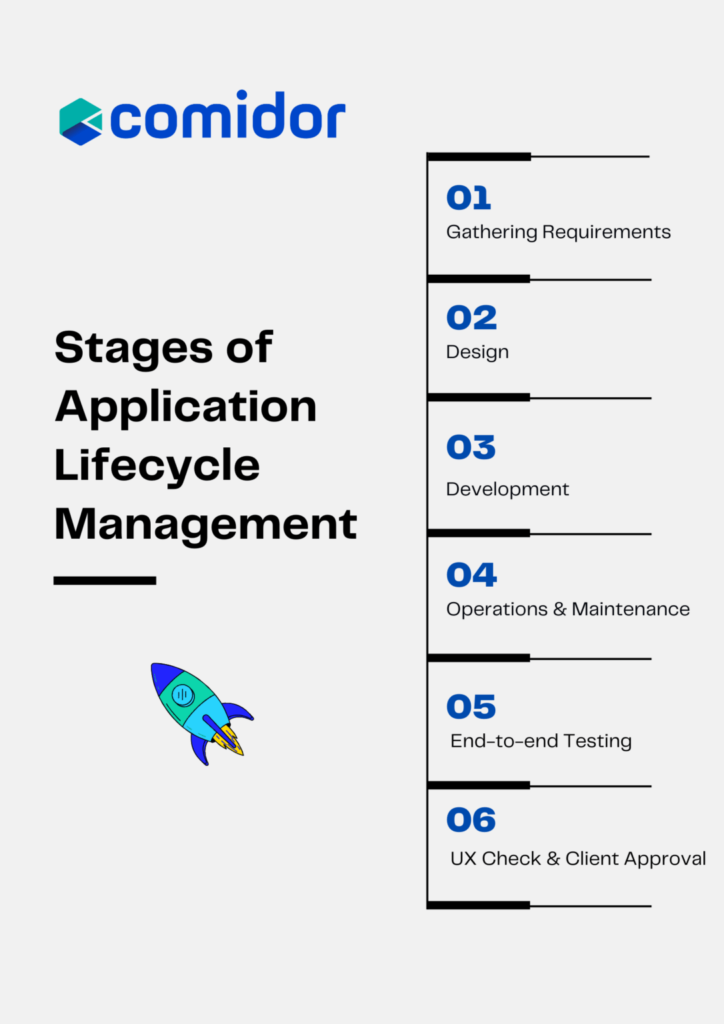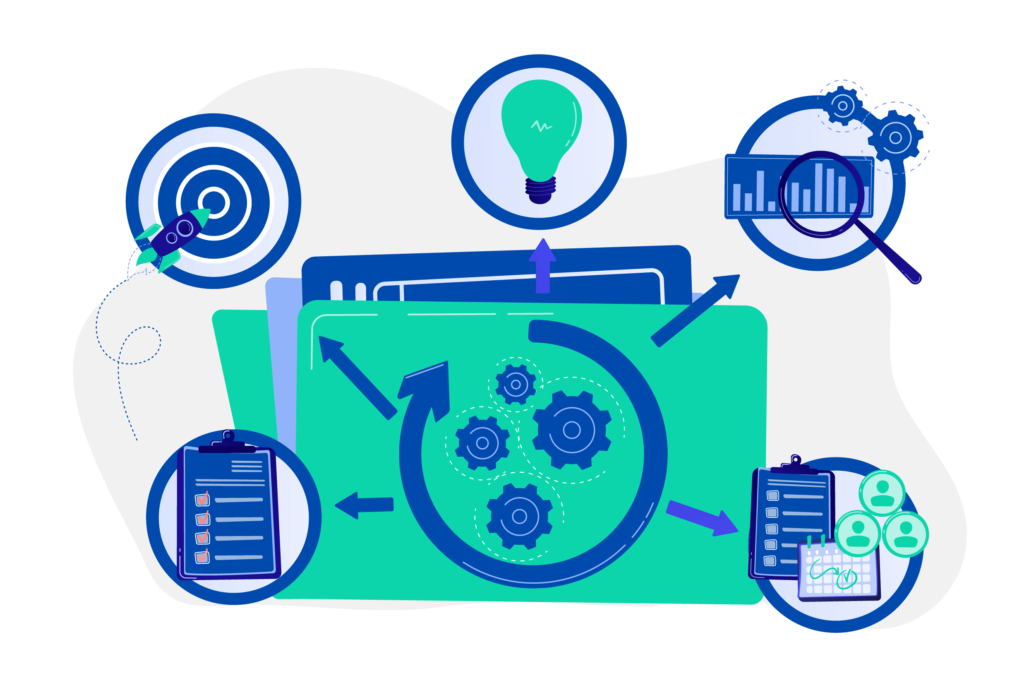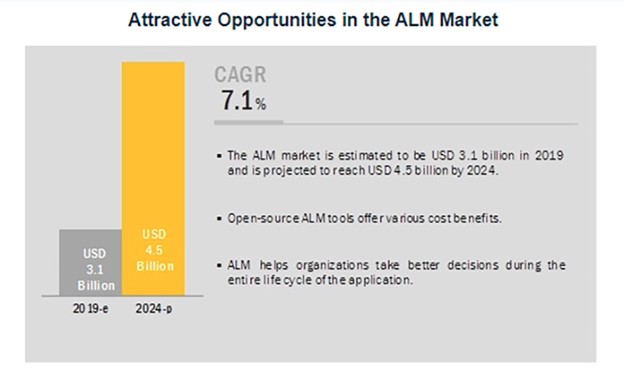The tremendous growth of technology has made it necessary for businesses to handle an enormous number of business applications and software. The need to manage applications from start to finish is not as easy as it can be thought, yet it is crucial. That is where Application Lifecycle Management (ALM) comes into play, which we will be discussing in this article. In this blog, we will go through what Application Lifecycle Management (ALM) is, what steps to follow to get better results, and why it is crucial.
What is Application Lifecycle Management (ALM)?
Application Lifecycle Management refers to the whole lifecycle of an application. The management of the application starts right from the conception of the idea, followed by the application’s specifications, designing, development, testing as well as the UX. Every phase has its significance and thus needs considerable handling throughout the lifecycle of the application.
It is indeed one of the attractive markets currently.
Very often, Application Lifecycle Management is mistakenly associated with the Software development Life Cycle. However, ALM is different from SDLC. The former is comparatively vast than the latter, though there is a certain level of relevancy among them. The ALM’s vastness is due to the inclusion of its development stages. Therefore, in the simple sense, ALM is what includes the people, tools, as well as methods that manage the entire life cycle, i.e., from the conception of the application to its end. It is made up of various disciplines such as management of the projects, required tools, and materials, software, test, qualifying, as well as maintaining a particular application.
Why Application Lifecycle Management (ALM) is important
As discussed, the first and foremost reason why ALM is important is that every application demands a proper strategy in order to be managed. Apart from this, there are various reasons that convey the need for well-established Application Lifecycle management. These are the following:
Achieving Smooth And Organized Development Process
Application development requires a lot of resources gathering and maintenance. Without a proper guideline, the whole process may be left hanging in the air. Having planned a proper Application Lifecycle Management (ALM) contributes to creating a centralized hub for all the related information that’s required. With this, the entire process becomes visible, traceable and renders accountability for a perfect work flow. Thus, coming up with an excellent ALM practice lightweights the process and pre-establishes the plan as well as requirements to transform a mere idea into a unique application.
Managing The Budget And Productivity
Whenever the client approaches a project, the first phase would be to discuss the design, requirements, and along with it, the required resources. With Application Lifecycle Management (ALM), the process is streamlined. Moreover, it strives to eliminate the need for various environments for testing. And with everything present in ALM, the management and the review phase are more efficient. This way, needed resources are less, which also contributes to reduced costs and increased productivity.
Enhancing Speed And Quality
It is quite challenging and time-consuming to keep track of the project’s status manually. However, with well-planned Application Lifecycle Management (ALM), this challenge is easy to overcome. It eradicates the loopholes that exist in coordination between team members and strengthens them to meet the set deadlines. Moreover, the transparency of the entire project improves the quality of the work done, as it reduces dependency to a large extent. And thus, ALM enables the application’s project to reach the target not just speedily but also enhances its quality.
Stages of Application Lifecycle Management
Having gone through and understanding the importance of Application Lifecycle Management, the urge to implement one is obvious. Yet, before we proceed with implementation, there is also the need to understand the different stages of Application Lifecycle Management (ALM). This awareness will definitely contribute to a smooth flow as well as reduce interruptions that may arise during the process. And for this reason, let’s move ahead to have a brief understanding of the various stages that ALM goes through.
 1. Gathering Requirements
1. Gathering Requirements
Gathering all the requirements is the first step of Application Lifecycle Management (ALM). Enabling proper management for all the requirements contributes to the enhancement of the project’s documentation, analysis, prioritization, and monitoring for what’s missing. Unless this stage is successfully accomplished, it becomes quite tricky to move ahead. Thus, the first stage of ALM makes sure that the further process is smoothly carried on by paving the path with all the requirements in place.
2. Design
Under this stage, the Application Lifecycle Management (ALM) focuses more on enhancing the customer’s satisfaction by looking into every minute detail of the project’s usability. It tries to make sure that the product’s and customer’s interactions are seamless. When this stage is properly obliged to, it definitely contributes to the satisfaction and loyalty of the clients.
3. Development
This is the stage where the transformation of the idea into an actual application takes place. At this stage, the code is gradually converted into standalone components of the software. Thus, here, the application is created, deployed, as well as tested, following numerous testing scenarios.
4. Operations And Maintenance
After the development stage comes the stage of operations and maintenance. This stage of the Application Lifecycle Management (ALM) includes the beginning of checking, controlling, executing, and developing the project’s application. Any identified bugs are resolved at this stage. Also, further enhancements are made to release the new updates that are needed.
5. End-to-end Testing
The end-to-end testing stage provides the testers with the opportunity to evaluate and verify if the project’s application complies with all the requirements that were determined during the initial stages. The testers try to make sure that the client’s requirements are met. During this phase, at times, it may be found that there might be a few changes that were not defined earlier, just to make sure that the outcome of the project is well. Towards the end, the goal is to ensure that the application succeeds in exhibiting a good user expectation during the entire lifecycle.
6. UX check and Client Approval
As mentioned earlier, the ultimate motive of carefully going through each and every stage is to make sure that the customers are satisfied. And they will be satisfied if the experience that they have with the product is appreciable. Therefore, once the testers have checked the product, the users are given a chance to evaluate the product based on the requirements they specified. Once the client evaluates and submits the feedback, finally the application can be moved ahead for its delivery.
Advantages of Application Lifecycle Management (ALM)
 A few worth-mentioning benefits of the Application Lifecycle Management (ALM) are :
A few worth-mentioning benefits of the Application Lifecycle Management (ALM) are :
Improving User Satisfaction
We are very well aware that the satisfaction of the users is reflected in their productivity. Discussing the same in one of its works, factoHR has stated that increasing satisfaction directly impacts and increases the employee’s consistency in work that leads to a more precise outcome. However, relating this to the implementation of ALM, it provides the users the required freedom to utilize the tools of their interest. This leads to more satisfaction and motivation.
Making Real-Time Decision-Making Possible
The need to enlightening managers with real-time data and the status of the project update is pretty high. ALM empowers businesses to make the right and timely decisions that are required. Moreover, it helps in decision-making taking into account both the people and the processes.
Contributing To Team Management
Whatever the application is, or whenever the process is executed, team management is an undeniable aspect. Despite the situation of people working remotely, the need for coordination between the teammates is not compromisable. But then, the concern is, what do we do? Well, with ALM in place, the worry regarding lack of communication and coordination is solved. The Application Lifecycle Management (ALM) provides an opportunity for the teammates to keep track of the processes, the project’s status, etc., in real-time.
Boosting Development Agility
The competitiveness among the businesses is increasing gradually. Being agile is a must for businesses in order to sustain themselves in the market. Especially when it comes to application development, the battle that exists is humongous. In such situations, embracing ALM gives an added benefit to remain competitive. The reason is that it is recognized as the one that contributes to the company’s competitive edge making the application development process streamlined and easily controllable.
Acquiring happy customers
As a known fact, a company’s all efforts to come out with the best product or service is to ensure customer’s happiness and thereby their loyalty to the business. However, if you are into developing a software application, the Application Lifecycle Management (ALM) indeed paves the path for customer happiness. The undergoing processes include the adaption, and support, along with the updates received from the clients as well. Moreover, ALM’s visibility and transparency amidst both employees and clients give them an added advantage. Thus, the clients have the opportunity to request the modification of the application anytime during its development process.
Best features of ALM tools
We have analyzed the importance, stages, and benefits of Application Lifecycle Management (ALM) so far. But, there’s yet another tiny challenge that exists once the decision is made. The technology has given rise to many players who deal with ALM tools. How to decide which one’s better? – is what is the primary concern. Well, in order to help you with that, here is a list of the important features that every ALM tool should have. Therefore, while making a choice, take into account the below checklist:
- Excellent support
- Extensive automation capabilities
- Seamless integration with internal and external systems
- User-friendly collaboration features
- Real-time reporting and performance analytics
Conclusion
In the fast-growing digital development era we live in, it is challenging to build an application without an Application Lifecycle Management (ALM) plan in place. In order to have not just a clear-cut goal but also to have efficient execution of the required process, an ALM solution is a crucial need. Therefore, do not further delay to embrace ALM, which will definitely guide your application development to a successful venture.
Turn fresh ideas
into applications with Comidor





